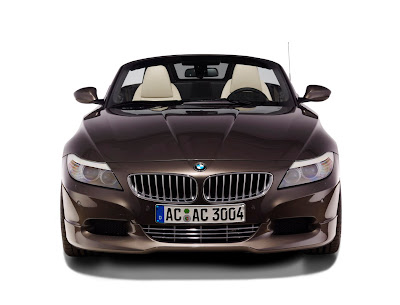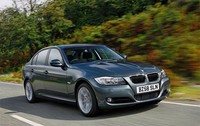




Of course, when the market said otherwise and other companies — Land Rover and Mercedes in particular — started selling overpowered and sometimes supercharged SUVs, BMW was almost forced to respond in kind.
Nonetheless, Bavaria’s best has fudged a little with the designation. Unlike its various sedans and coupes that wear the most desired of lettered aftermarket tuning badges before their model designation — M3, M5 or M6 — the company’s SAVs wear their iconic M after the standard badging, as in the X6M. You may well think I’m nicking pits but the subtle implication is that while the breathed-on sedans and coupes are disassembled and re-engineered from the ground up, the suffixed “M” infers that its wearer has added a sport kit to the standard item.
This just isn’t right. I’m jamming into Road Atlanta’s infamous Gravity Cavity at more than 200 kilometres an hour, the entire vehicle getting seriously light over the big hump that drops into Turn 10. First, the slight kink at the end of the back straight loads the outside tires and then, when the road drops out from under you, the X6M suddenly humps sideways. At 100 km/h, this kind of behaviour would be all lighthearted fun. At 230 km/h, it may still be a whole lot of fun, but there’s a sense of drama not captured at more sensible speeds.
That sense of foreboding should be dramatically heightened since I’m not, in fact, driving a sports car typical for such race track shenanigans. The real reason the situation needs a massive amount of adjustment isn’t that I’m slewing sideways at 230 km/h but that I’m slewing sideways at 230 km/h in a sport-utility vehicle. OK, so it’s a Sports Activity Vehicle because that is BMW’s affectation for its faux roaders, but the appellation hardly alters the fact that I’m racing around in something with an SUV’s profile and a centre of gravity somewhere around my ears.
Thankfully, the SAV I am flinging about with an almost devil-may-care attitude has been thoroughly massaged by BMW’s M division. Indeed, without BMW’s famed motor-sports division’s ministrations, chances are the X6 I’m driving with such élan would have ended up off the race track, say in neighbouring North Carolina. The X6M is the first off-roader to ever receive BMW’s M badge, a significant fact considering that, not so very long ago, the concept of a high-performance SUV was pooh-poohed by the good folks at BMW.
The transformation to M missile is actually quite easy for BMW. For one thing, unlike the M5’s V10, which is purpose-built, the X6 M’s basic engine — the twin-turbo V8 — already exists in the more basic X6 xDrive50i. BMW massages the big 4.4-litre engine to a staggering 555-horsepower output by rerouting the turbocharger plumbing more efficaciously (both turbos are nestled in the vee between the cylinders where the intake manifold normally resides) and by having both banks of cylinders drive both turbochargers through a set of headers that would do any hot rodder proud. That BMW has also turned the turbo boost up to an astonishing 22 psi is both the reason for the crazed power numbers and proof that the company’s basic 4.4L V8 is truly overbuilt.
Such techno gibberish may wow spinning propellor types like Yours Truly, but all that matters to the person behind the leather-clad steering wheel is that the twin-turbo V8 delivers its maximum 500 pound-feet of torque all the way from 1,500 rpm to an incredible 5,650 rpm. The sensation is of endless power and, when you stand on the loud pedal, the X6 M jumps ahead no matter what the rpm.
It might have jumped in even more dramatic fashion did it not weigh in at a portly 2,305 kilograms. Even though that translates into an almost gargantuan 5,080-pound curb weight, BMW still claims a zero-to-100 km/h time of 4.7 seconds, which is way deep into sports car territory. It’s scary to imagine what this drivetrain might accomplish in a lighter chassis.
All that avoirdupois has seemingly little effect on the X6M’s handling. Oh, sure, the SAV might handle even better were it to shed a thousand kilos or so, but there is truly little to deride in the comportment department.
Everyone returned from their maximum adrenalin lapping of Road Atlanta positively amazed at how well the big X6 M managed its high-speed foray. The brakes — big, four-piston calipers up front — faded but little, the variable-effort Servotronic steering had plenty of feel and, despite serious attempts at clipping apexes, there was precious little body roll. This last is made all the more amazing since the M’s ride is as accommodating as the basic X6’s.
Traction was equally impressive as the X6 M’s big 20-inch wheels wear sticky low-profile performance radials (P315/ 35R20 in the rear and P275/ 40R20 in the front). And even when enthusiasm does get the better of judgment, BMW’s stability control system brings the big X6 back into line.
The rest of the M is very much standard X6 save for some optional trim bits such as the carbon fibre-patterned leather surrounding the centre console and inlaid throughout the doors. That means it’s roomy in both rows of seats, has plenty of headroom fore and aft and there’s a good-sized trunk, though you can’t pack luggage as high as you can in an X5 because of that sloping roof. That so much of the basic X6 is carried over is one of the reasons the M’s sticker price is an almost reasonable $99,900.
The only thing stopping a complete affirmation of the X6 M’s prowess is the ever more resounding question of who really needs an SUV with a coupe-like sloped roof, all-wheel drive and 555 hp that weighs only slightly less than an Escalade? It’s a little like watching Serena Williams out-hustle the lithe twig-like figures that make up the rest of the female tennis world; I admire the triumph of enthusiasm over genetics and am amazed how something so muscular can at the same time be so graceful. Nonetheless, I can’t help but think that both would be better served if they lost a few kilograms.
THE SPECS
Type of vehicle: All-wheel-drive, mid-sized luxury SUV
Engine: Twin-turbocharged 4.4L DOHC V8
Power: 555 hp @ 6,000 rpm; 550 lb-ft of torque @ 5,650 rpm
Transmission: Six-speed manumatic
Brakes: Four-wheel disc with ABS
Tires: P275/40R20 front; P315/35R20 rear
Price: base/as tested: $99,900/$111,850
Destination charge: $1,995
Transport Canada fuel economy L/100 km: 13.5 city, 9.5 hwy.
Standard features: Power door locks, windows and mirrors, four-zone climate control air conditioning with micron air filter, 16-speaker AM/FM/CD audio system, steering wheel-mounted audio controls, DVD navigation system, electronic cruise control, power sunroof, information display, tilt and telescoping steering wheel, leather seats, 10-way power front seats, heated front seats, heated steering wheel, auto headlights, Dynamic Stability Control with M Dynamic Mode, Automatic Stability Control + Traction, Dynamic Brake Control, Dynamic Traction Control, Hill Descent Control.








































